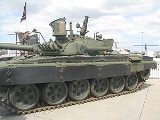
T-72 operators and variants
Encyclopedia
The T-72 is a Soviet
-designed main battle tank
that entered production in 1971. It replaced the T-54/55 series as the workhorse of Soviet tank forces (while the T-64
and T-80
served as the Soviet high-technology tanks). In front-line Russian service T-72 are being replaced by T-90
, a modernized version of the T-72. While in the Ukraine T-72s are being replaced by the T-80
and T-84
MBTs. It has been exported and produced in many countries.

 This list does not include operators of the Yugoslavian
This list does not include operators of the Yugoslavian
M-84
.
– 40 – 500 – 22 T-72M1 bought from Belarus in 1999. – 160 – 180 T-72A en T-72B in 2003. – 1,465 T-72B. – 160 T-72M2 and a large number (some 270) in reserve. – About 50 Т-72М1 – 543 inherited from former Czechoslovakia in 1993. 179 T-72 main battle tanks in service as of 1 January 2008. – 42 bought from Yemen. – 50 bought from Yemen, 200 reportedly ordered from Ukraine in 2011. – 50 T-72A and T-72M1 in 2004. 140 T-72A, T-72M1 and T-72B in 2005. 170 T-72M1, T-72B and T-72Sim1 in 2007. Approximately 200 T-72B1 and T-72Sim1 in 2008, 169 Т-72B1 and T-72Sim1 as of 2009. – 195 T-72M and T-72M1 in 2009. To be retired after 2010. – 1,900 T-72M and T-72M1 as of 2008 – 480 T-72M1 and T-72S since 2002. – 1000 T-72s, T-72Ms, T-72M1s, Lion of Babylon and Saddam tanks were in service with Iraqi Army
in 1990. 375 T-72s, T-72Ms, T-72M1s, Lion of Babylon and Saddam tanks were in service with Iraqi Regular Army in 2003. Only 120 T-72M1 are in service as of 2009 with the new Iraqi Army. - 980 – 77 T-72AV from Ukraine in 2007. 33 delivered in Feb 2009 may bring total to 110. - 215 – 150 in 2003.
.
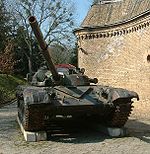
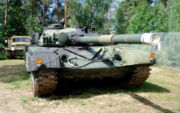

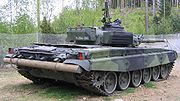
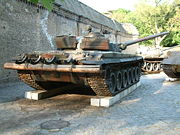

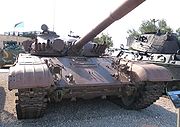
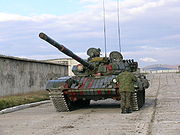
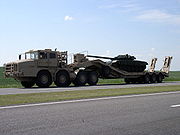 The T-72 was designed and first built in the Soviet Union.
The T-72 was designed and first built in the Soviet Union.
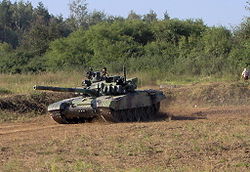
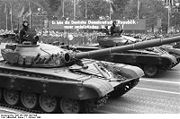

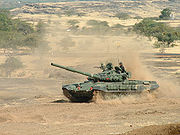
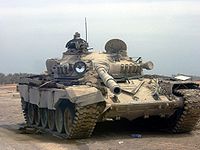
Iran reached an agreement with Poland early in 1995 to buy 100 T-72s. Russia delivered 100 T-72S tanks to Iran in 1994 and another two in 1996 to fulfill an agreement signed in 1993,and from 1996 to 1999 delivered 300 T-72S kits to Dordud. The assembled tanks were first brought into service in July 1998. Thus, from 1993–2000, Iran received 422 T-72S tanks. The November 1991 contract for the licensed production of tanks was only 30% fulfilled: equipment not sent included 578 T-72S kits.
Iran is believed to operate 480 T-72M1 and T-72S (not to be confused with T-72Z, upgraded T-54/55) since 2002.
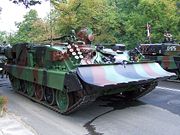
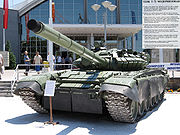
Soviet Union
The Soviet Union , officially the Union of Soviet Socialist Republics , was a constitutionally socialist state that existed in Eurasia between 1922 and 1991....
-designed main battle tank
Main battle tank
A main battle tank , also known as a battle tank or universal tank, is a tank that fills the heavy direct fire role of many modern armies. They were originally conceived to replace the light, medium, heavy and super-heavy tanks. Development was spurred onwards in the Cold War with the development...
that entered production in 1971. It replaced the T-54/55 series as the workhorse of Soviet tank forces (while the T-64
T-64
The T-64 is a Soviet main battle tank, introduced in the early 1960s. It was used solely by the Soviet Army in its front-line divisions and was a more advanced counterpart to the T-62...
and T-80
T-80
The T-80 is a main battle tank designed and manufactured in the former Soviet Union. A development of the T-64, it entered service in 1976 and was the first production tank to be equipped with a gas turbine engine for main propulsion.the Swedish Stridsvagn 103 of 1971 used a gas turbine alongside...
served as the Soviet high-technology tanks). In front-line Russian service T-72 are being replaced by T-90
T-90
The T-90 is a Russian third-generation main battle tank that is a modernisation of the T-72 . It is currently the most modern tank in service with the Russian Ground Forces and Naval Infantry...
, a modernized version of the T-72. While in the Ukraine T-72s are being replaced by the T-80
T-80
The T-80 is a main battle tank designed and manufactured in the former Soviet Union. A development of the T-64, it entered service in 1976 and was the first production tank to be equipped with a gas turbine engine for main propulsion.the Swedish Stridsvagn 103 of 1971 used a gas turbine alongside...
and T-84
T-84
The T-84 is a Ukrainian main battle tank, a development of the Soviet T-80 main battle tank. It was first built in 1994 and entered service in the Ukrainian Armed Forces in 1999. The T-84 is based on the diesel-engined T-80 version, the T-80UD...
MBTs. It has been exported and produced in many countries.
Current operators


Socialist Federal Republic of Yugoslavia
The Socialist Federal Republic of Yugoslavia was the Yugoslav state that existed from the abolition of the Yugoslav monarchy until it was dissolved in 1992 amid the Yugoslav Wars. It was a socialist state and a federation made up of six socialist republics: Bosnia and Herzegovina, Croatia,...
M-84
M-84
The M-84 is a Yugoslav 2nd generation main battle tank. The M-84 is in service in Bosnia and Herzegovina, Croatia, Kuwait, Slovenia and Serbia.-Development and production:...
.
– 40 – 500 – 22 T-72M1 bought from Belarus in 1999. – 160 – 180 T-72A en T-72B in 2003. – 1,465 T-72B. – 160 T-72M2 and a large number (some 270) in reserve. – About 50 Т-72М1 – 543 inherited from former Czechoslovakia in 1993. 179 T-72 main battle tanks in service as of 1 January 2008. – 42 bought from Yemen. – 50 bought from Yemen, 200 reportedly ordered from Ukraine in 2011. – 50 T-72A and T-72M1 in 2004. 140 T-72A, T-72M1 and T-72B in 2005. 170 T-72M1, T-72B and T-72Sim1 in 2007. Approximately 200 T-72B1 and T-72Sim1 in 2008, 169 Т-72B1 and T-72Sim1 as of 2009. – 195 T-72M and T-72M1 in 2009. To be retired after 2010. – 1,900 T-72M and T-72M1 as of 2008 – 480 T-72M1 and T-72S since 2002. – 1000 T-72s, T-72Ms, T-72M1s, Lion of Babylon and Saddam tanks were in service with Iraqi Army
Iraqi Army
The Iraqi Army is the land component of the Iraqi military, active in various forms since being formed by the British during their mandate over the country after World War I....
in 1990. 375 T-72s, T-72Ms, T-72M1s, Lion of Babylon and Saddam tanks were in service with Iraqi Regular Army in 2003. Only 120 T-72M1 are in service as of 2009 with the new Iraqi Army. - 980 – 77 T-72AV from Ukraine in 2007. 33 delivered in Feb 2009 may bring total to 110. - 215 – 150 in 2003.
-
-
 Anti-Gaddafi forcesAnti-Gaddafi forcesThe anti-Gaddafi forces were Libyan groups that opposed and militarily defeated the government of Muammar Gaddafi, killing him in the process. These opposition forces included organised and armed militia groups, participants in the 2011 Libyan civil war, Libyan diplomats who switched their...
Anti-Gaddafi forcesAnti-Gaddafi forcesThe anti-Gaddafi forces were Libyan groups that opposed and militarily defeated the government of Muammar Gaddafi, killing him in the process. These opposition forces included organised and armed militia groups, participants in the 2011 Libyan civil war, Libyan diplomats who switched their...
- Unknown number captured from Libyan Army/provided by defectors. – 30 T-72A and 1 T-72AK from Ukraine. – 200 – 139 T-72S – Probably a T-72S was sold to the North Koreans in the early 1990s. – 586 T-72M1 and T-72M1D (2006, 2007 - 597, 2005 - 644, 2004 - 649 ) and 135 T-72M1Z (T-72M1 upgraded to PT-91 standard) (Also 98 PT-91 in service) Plans to withdraw the T-72M1 in 2018. – 1,200 in active service, 8000 in reserve – 33 T-72M1 to be retired at end 2011. – 32 T-72s from the MV FainaMV FainaThe MV Faina is a roll-on/roll-off cargo ship operated by a Ukrainian company that sails under a Belize flag of convenience.The Faina is owned by Waterlux AG, based in Panama City, and managed by Tomex Team in Odessa, Ukraine....
as well as 67 T-72s from previous arms shipments. – 10 Used during in the 2008 South Ossetia War. – 1,600 - 44 - 702 – 1,180 Most retired in favor of T-80T-80The T-80 is a main battle tank designed and manufactured in the former Soviet Union. A development of the T-64, it entered service in 1976 and was the first production tank to be equipped with a gas turbine engine for main propulsion.the Swedish Stridsvagn 103 of 1971 used a gas turbine alongside...
and T-84T-84The T-84 is a Ukrainian main battle tank, a development of the Soviet T-80 main battle tank. It was first built in 1994 and entered service in the Ukrainian Armed Forces in 1999. The T-84 is based on the diesel-engined T-80 version, the T-80UD...
some in reserve. – 70 – 92 T-72BM ordered – 480 T-72M1 in the 2005, supplied by Poland. – 39 in 2003.
-
Former operators
– About 1,700 T-72/T-72M/T-72M1 were produced between 1981 and 1990. The Czechoslovak army had 815 T-72 in 1991. All were passed on to the successor states. – 35 T-72 (from USSR), 219 T-72 (from Poland and Czechoslovakia), 31 T-72M (from USSR), 162 T-72M (from Poland and Czechoslovakia) and 136 T-72M1. 75 T-72's were fitted with additional hull armour. Passed on to the unified German state. – Some 160-170 T-72M1s. About 70 T-72M1s (one armoured brigade) were bought from the Soviet Union and were delivered in 1984, 1985–1988 and 1990. A further 97 T-72M1s (including a small number of command versions T-72M1K and T-72M1K1) were bought from German surplus stocks in 1992-1994. All are now withdrawn from service and have been scrapped or sold as spares to the Czech Republic. – 549 tanks taken from GDR's army, all scrapped, sold to other countries or given to the museums. – Passed on to successor states. – 30 T-72M were bought in 1978 from USSR and delivered in 1979. Withdrawn from service (in long term storage), 28 tanks are for sale (23 of them need repairs and 5 are operational). – Bought approx. 70 T-72s from the USSR, later developed the improved M-84M-84
The M-84 is a Yugoslav 2nd generation main battle tank. The M-84 is in service in Bosnia and Herzegovina, Croatia, Kuwait, Slovenia and Serbia.-Development and production:...
.
Evaluation-only operators
Soviet Union and Russian Federation









- T-72 "Ural" (Ob'yekt 172M) (1973) - Original version, armed with 125 mm D-81TM smoothbore tank gun. Unlike the later versions it had the searchlight mounted on left. It also has flipper type armour panels. It had the TPD-2-49 coincidence optical rangefinder sight protruding from its turret.
- T-72K - Command version of T-72 "Ural" with an additional R-130M radio. Company command versions were fitted with two R123M/R-173 additional radios and also carried a 10 m telescopic mast. Battalion and regiment command versions were fitted with two R123M/R-173 additional radios and the R-130M that uses the 10 m mast when its erected. In NATO code T-72K was represented by three different designations: T-72K1, T-72K2 and T-72K3 which represented the company command version, battalion command version and regiment command version.
- T-72 (Ob'yekt 172M-E, Ob'yekt 172M-E1) - Soviet export version armed with 125 mm D-81T smoothbore tank gun with 44 rounds. It was sold to Iraq and Syria and was also built in Poland by "Bumar-Łabędy".
- T-72 fitted with a French 155 mm F1 turret for trails in India.
- T-72 fitted with a British 155 mm Vickers T6 turret for trails in India.
- Robot-2 - Remote controlled T-72 "Ural".
- Ob'yekt 172-2M "Buffalo" - Modernization of T-72 made in early 1970s. The angle of the front armour slope was changed to 30 degrees. 100% metal side-skirts protecting sides of the hull, added armour screens protecting the turret, ammo storage was increased to 45 rounds, modified suspension, added smoke grenade launchers, engine's power was boosted to 840 hp.
- T-72 "Ural-1" (Ob'yekt 172M1) (1976) - new 2A46 main gun, new armour on the turret.
- T-72V - ("V" for vzryvnoi - explosive) unofficial designator for tanks, fitted with Kontakt-1 explosive reactive armour fitted to hull front and turret.
- T-72 "Ural" modernization. Large numbers of early T-72 production models were modernized in 1980s. The modernization included placing the search light on the right-hand-side of main armament, blanking off the TPD-2-49 coincidence optical rangefinder and fitting of rubber skirts protecting the tracks instead of the flipper type armor panels.
- T-72A (Ob'yekt 176) (1979) - An improved version of the basic T-72 "Ural". Overall, its offensive capabilities are similar to the basic T-72 "Ural", but it is much better protected. The differences between T-72 "Ural" and T-72A include the searchlight being placed on the right hand side of turret, the TPD-2-49 coincidence optical rangefinder being replaced by the TPD-K1 laser rangefinder, added plastic armour track skirts covering the upper part of the suspension with separate panels protecting the sides of the fuel and stowage panniers instead of the flipper type armor panels used in T-72 "Ural", the turret front and top being heavily reinforced with composite armour better known by its US codename - "Dolly Parton", provisions for mounting reactive armor, an electronic fire control system, MB smoke grenade launchers, flipper armour mount on front mudguards, internal changes, and a slight weight increase.
- T-72A obr.1979g - Additional glacis armour with thickness of 17 mm of high resistance steel.
- T-72A obr.1984g - Late production model with anti radiation lining.
- T-72AK (Ob'yekt 176K) - Command version of T-72A. In NATO code T-72AK was represented by three different designations: T-72AK1, T-72AK2 and T-72AK3 which represented the company command version, battalion command version and regiment command version.
- T-72AV - ("V" for vzryvnoi - explosive) model with Kontakt-1 explosive reactive armour fitted to hull front and turret.
- T-72M (Ob'yekt 172M-E2, Ob'yekt 172M-E3, Ob'yekt 172M-E4) - Soviet export version, similar to T-72A but with thinner armour and downgraded weapon systems. Also built in Poland and ex-CzechoslovakiaCzechoslovakiaCzechoslovakia or Czecho-Slovakia was a sovereign state in Central Europe which existed from October 1918, when it declared its independence from the Austro-Hungarian Empire, until 1992...
- T-72MK (T-72M(K)) - Export version of T-72AK. It is a command vehicle for battalion commanders and has additional radio equipment including the R-130M radio, AB-1-P/30-M1-U generator and a TNA-3 navigation system. The main external difference is a 10 m telescopic antenna stowed under the rear of the stowage box during travel. An additional antenna base for this telescopic antenna is mounted on the left side of the turret. Because of the additional equipment the number of round for the 125 mm tank gun had to be lowered from 44 to 38. In NATO code T-72MK was represented by three different designations: T-72MK1, T-72MK2 and T-72MK3 which represented the company command version, battalion command version and regiment command version.
- T-72M1 (Ob'yekt 172M-E5, Ob'yekt 172M-E6) - Soviet export version, with thicker armour and similar to T-72A obr.1979g. It also is fitted with 7+5 smoke grenade dischargers on turret front. (built also in Poland and ex-Czechoslovakia).
- T-72M1K - Commander's variant with additional radios.
- T-72M1V - T-72M1 with Kontakt-1 explosive reactive armour ("V" for vzryvnoi - explosive).
- T-72M1M (Ob'yekt 172M-E8) - Soviet export version. It's a T-72M1 upgraded to T-72B standard. It has the Arena Active Protection SystemArena Active Protection SystemThe Arena is an active protection system developed at Russia's Kolomna-based Engineering Design Bureau for the purpose of protecting armoured fighting vehicles from destruction by light anti-tank weapons, anti-tank guided missiles , and missiles with top attack warheads. It uses a Doppler radar...
.
- T-72B (Ob'yekt 184) (NATO code: SMT M1988) {1985} (SMT - Soviet Medium Tank) - Much improved version with 1A40-1 fire control system, thicker armour, turret front and top was heavily reinforced with composite armour better known by its US codename "Super Dolly Parton", 20 mm of appliqué armour in the front of hull, 9K120 system which gives T-72B 9M119 "Svir" (NATO code: AT-11 Sniper) laser-guided antitank missile capability, new 2A46M main gun, 1K13-49 sight, stabilization system, and a new V-84-1 engine with 840 hp (626 kW). On early models the smoke dischargers were mounted on the turret front (as per T-72A), later they were grouped on the left side of the turret to prepare for the installation of ERA bricks.
- T-72BA ERA fitted with 227 "Kontakt-1" ERA bricks to the hull and turret. The glacis plate and turret is covered with a layer of single ERA blocks and the turret's bottom row is mounted horizontally. There's also an ERA array on the sideskirts. They're often incorrectly called T-72BV.
- T-72BK (Ob'yekt 184K) - Command version of T-72B, recognizable by having multiple radio antennas and a radio mast stowage under rear turret bin.
- T-72S "Shilden" (T-72M1M1, Ob'yekt 172M-E8) - Export version of T-72B with only 155 ERA bricks, simplified NBC system, no anti-radiation lining etc.
- T-72B1 (Ob'yekt 184-1) - T-72B without ATGM capability and with the T-72A's optics.
- T-72B1 fitted with "Kontakt-1" ERA. It has eight SGD on left-hand-side of the turret and explosive reactive armour on turret and hull front.
- T-72B1K (Ob'yekt 184K-1) - Command version of T-72B1.
- T-72B obr.1989g - T-72B equipped with advanced Kontakt-5Kontakt-5Kontakt-5 is a type of third-generation explosive reactive armour originating in the Soviet Union. It is the first type of ERA which is effectively able to defeat modern armour-piercing fin-stabilized discarding sabot rounds....
explosive reactive armour, composite armour in sides of turret as well. Often called T-72BM or T-72B(M) but this is not correct. NATO code: SMT M1990. - T-72B obr.1990g - Additionally fitted with new FCS, cross-wind sensor and sometimes V-92S2 engine.
- T-72B obr.1990g with an improved commander's cupola with a larger sight.
- T-90 (Ob'yekt 188) - This is a further development of the T-72, incorporating many features of the heavier, more complex T-80. It was first called T-72BU
- T-72B obr.1990g with an improved commander's cupola with a larger sight.
- T-72BM "Rogatka" obr.2006g (Ob'yekt 184M) - Upgrade of T-72B under "Rogatka" programme. First shown at the 2006 Russian Arms Expo, it is upgraded with new fire control system including a gunner's thermal sight, "NakidkaNakidkaNakidka is a Russian Radar-absorbent material camouflage that "eliminates the use of precision-guided weapons" Nakidka reduces the Infrared, Thermal, and Radar band signatures of an object...
" camouflage kit, new 125 mm 2A46M-5 main gun with muzzle reference system, V-92S2 1,000 hp diesel engine and new "Relikt" 3rd generation explosive reactive armour which is claimed to be twice as effective as Kontakt-5.
- BMO-T (Boyevaya Mashina Ognemyochikov) - This is a transport vehicle for flamethrower-squads armed with RPO launcher.
- BMPTBMPTThe BMPT "Ramka" is a new Russian armored vehicle designed to support tank and infantry operations, primarily in urban areas.This vehicle is sometimes nicknamed the "Terminator"...
(Ob'yekt 199) - Heavy convoy and close tank support vehicle (Boyevaya Mashina Podderzhki Tankov). All new turret armed with 2 30 mm 2A42 autocannons (500 rounds), 1 boxed 9M133 Kornet ATGM launcher on left-hand-side of weapons mount (4 rounds), AGS-17/30 30 mm grenade launchers and a 7.62 mm PKT MG (2,000 rounds). It be also fitted with either 2 7.62 mm PKT MGs or 30 mm AGS-17/30 as bow weapons and a 902A "Tucha" 81 mm smoke grenade launcher array. Features new fire control system with thermal sights and a ballistic computer and 3rd generation "Relikt" explosive reactive armour and "Kaktus" modular armour. It is equipped with Agat-MR passive and thermal night vision devices, an NBC detection and protection system, a crosswind sensor and parts of the KAZ "Shtora" active protection system. The vehicle can be fitted with either the KMT-8 or the EMT mine clearing system. It also has the engine from T-90A. The term BMP-T that is very often found is not correct. - TOS-1TOS-1TOS-1 is a Soviet 30-barrel or 24-barrel multiple rocket launcher and thermobaric weapon mounted on a T-72 tank chassis. TOS-1 was designed for defeating enemy personnel in fortifications, in open country, and in lightly armoured vehicles and transport...
- Large box-type multi-barrel napalm rocket launcher with 30 tubes that replaces turret. - TZM-T - Reloading vehicle for the TOS-1 mobile multi-barrel napalm rocket launcher.
- BREM-1 (Bronirovannaya Remonto-Evakuatsionna Mashina) - Armoured recovery vehicle with a hydraulic crane with capacity of 12 tonnes mounted at the front of the hull on the left side. It also has a main winch with capacity of 25 tons which can be increased to 100 tonnes, auxiliary winch, hydraulically operated dozer/stabilizing blade at the front of the hull, towing equipment and a complete range of tools and recovery equipment.
- BREM-1M - improved version fitted with one-piece side bin, a more powerful crane and improved recovery tools. The crew can remain inside the vehicle for recovery operations.
- IMR-2 (Inzhenernaya Mashina Razgrashdeniya) - Combat engineering vehicleCombat engineering vehicleMilitary engineering vehicles are vehicles built for the construction work or for the transportation of combat engineers on the battlefield. These vehicles can range from civilian equipment to purpose built military vehicles....
(CEV). It has a telescoping crane arm which can lift between 5 and 11 metric tons and utilizes a pincers for uprooting trees. Pivoted at the front of the vehicle is a dozer blade that can be used in a V-configuration or as a straight dozer blade. When not required it is raised clear of the ground. On the vehicle's rear, a mine-clearing system is mounted.- IMR-2M1 - Simplified model without the mine-clearing system. Entered service in 1987.
- IMR-2M2 - Improved version that is better suited for operations in dangerous situations, for example in contaminated areas. It entered service in 1990 and has a modified crane arm with bucket instead off the pincers.
- IMR-2MA - Latest version with bigger operator's cabin armed with a 12.7 mm machine gun NSV.
- Klin-1 - Remote controlled IMR-2.
- MTU-72 (Ob'yekt 632) (Tankovyj Mostoukladchik) - bridge layer based on T-72 chassis. The overall layout and operating method of the system are similar to those of the MTU-20 and MTU bridgelayers. The bridge, when laid, has an overall length of 20 meters. The bridge has a maximum capacity of 50,000 kg, is 3.3 meters wide, and can span a gap of 18 m. By itself, the bridge weighs 6400 kg. The time required to lay the bridge is 3 minutes, and 8 minutes for retrieval.
- RKhM-7 "Berloga-1" (Razvedivatel’naya Khimicheskaya Mashina) - NBC reconnaissance vehicle without turret and with fixed superstructure.
- Ob'yekt 327 - Self-propelled 152 mm gun. Prototype only.
Bulgaria
- T-72M2 - upgraded T-72M1 with new night vision and thermal devices, improved armour (up to 650 mm) and anti-radiation cladding, rubber side skirts, C4I and IR suppression coating.
Croatia
- M-84M-84The M-84 is a Yugoslav 2nd generation main battle tank. The M-84 is in service in Bosnia and Herzegovina, Croatia, Kuwait, Slovenia and Serbia.-Development and production:...
D Degman - More modern prototype based on the M-84. - M-95 DegmanM-95 DegmanM-95 Degman is a prototype Croatian main battle tank, developed in the factory Đuro Đaković specijalna vozila d.d., located in Slavonski Brod, Croatia. It is also known as the RH-ALAN Degman. The Đuro Đaković factory is best known for its principal role in the production of M-84, a Yugoslav version...
- 3rd generation tank based.
Cuba
- T-72 - A designation used for all unmodified T-72 main battle tanks in service with Cuba.
- T-72M1 (Not to be confused with Soviet T-72M1) - T-72 equipped with a Chinese radio set instead of the Soviet one and better protection for it against humidity, heat and bumps.
- T-72M2 (Not to be confused with Slovak T-72M2) - T-72 with steel protection shield in the front of the AA HMG.
Czech Republic

- T-72M3 CZ - T-72M3CZ includes the gunner's thermal image sight with two part doors and the tank's commander tall cylindrical thermal image sight. Tank's driver passive IR sight viewer leaves that and Laser range finder and the ballistic calculator make computerized and added internal navigation equipment - this variant was not accepted by the Czech Army in favour of T-72M4CZ.
- T-72M4 CZ - Added new ERA armour for protection from the HEAT and APFSDS round, additional armour array around turret with flat-face frontal aspect, MB smoke grenade dischargers on each side of turret. The tank is equipped with a new Galileo Avionica TURMS-T computerized FCS (it is equal to the one used in C1 Ariete), power pack was equipped with Perkins CV12-1000 740 kW/1,000 hp water-cooled diesel engine and an Allison XTG-411-6 automatic transmission. All drive train work was taken over by Israel NIMDA and the existing transmission instead of the Allison. Also the weight of the T-72M4CZ grew by 4 tonnes, tank's commander tall cylindrical sight is similar to the one used in French Leclerc MBT. Czech Republic has upgraded 30 tanks to the T-72M4CZ standard.
- VT-72M4 - Modernized VT-72 (BREM-72) ARV with T-72M4CZ upgrades including the power pack and communications upgrades.
- T-72M4 CZ - Added new ERA armour for protection from the HEAT and APFSDS round, additional armour array around turret with flat-face frontal aspect, MB smoke grenade dischargers on each side of turret. The tank is equipped with a new Galileo Avionica TURMS-T computerized FCS (it is equal to the one used in C1 Ariete), power pack was equipped with Perkins CV12-1000 740 kW/1,000 hp water-cooled diesel engine and an Allison XTG-411-6 automatic transmission. All drive train work was taken over by Israel NIMDA and the existing transmission instead of the Allison. Also the weight of the T-72M4CZ grew by 4 tonnes, tank's commander tall cylindrical sight is similar to the one used in French Leclerc MBT. Czech Republic has upgraded 30 tanks to the T-72M4CZ standard.
Former East Germany


- T 72M - This designator was not only used for the standard T-72M, but also for 75 basic T-72's that were upgraded by RWN in 1986. These tanks (Kampfpanzer) were fitted with rubber side skirts, smoke grenade launchers "Tucha" and the additional 16 mm steel plate on the upper glacis plate.
- T 72M "Übergangsversion" - East-German army designator for 23 late-production T-72M's from Poland, fitted with the additional hull armour. Delivered in 1986.
- T 72(K) and T-72(K1) - East-German army designators for command tanks (Führungspanzer).
- T 72TK - East German designation for VT-72B (BRAM-72B). The vehicle was planned to enter service with NVANational People's ArmyThe National People’s Army were the armed forces of the German Democratic Republic .The NVA was established in 1956 and disestablished in 1990. There were frequent reports of East German advisors with Communist African countries during the Cold War...
in 1990, but only one was actually handed over to IB-9 (Instandsetzungsbatallion 9) at Drögeheide (Torgelow). Two others were still in Grossenhain (Central tank workshop near Dresden) on 3 October 1990. At this place the tanks got fitted with relevant NVA kit and the cranes were tested/certified. - BLP 72 (Brückenlegepanzer) - The East-German army had plans to develop a new bridgelayer tank that should have been ready for series production from 1987 but after several difficulties the project was canceled.
- FAB 172M or FAP 172U (Fahrausbildungspanzer) - Driver training vehicle. Three vehicles were made by using the chassis of the cancelled BLP 72 project.
Former Czechoslovakia
- T-72M (Ob'yekt 172M-E3) - This model was built under licence by ZTS Martin. In Western sources it is often referred to as T-72G which might be the designator for the version exported to the Middle East. In the late 1980s the tanks produced for the Czechoslovak army and for export as well were fitted with some improvements from the Soviet T-72A programme, including rubber side skirts (instead of "gill armour") and 902B "Tucha" smoke grenade launchers.
- T-72M1 (Ob'yekt 172M-E5) - This export version of the T-72A was also build by Martin. An external difference with the Soviet original is the reduced number of KMT mounts on the lower glacis plate.
- VT-72 (BRAM-72) (Vyprošt’ovací Tank) - Czechoslovak armoured recovery vehicle based on T-72 chassis.
- VT-72B (BRAM-72B) - Czechoslovak ARV based on BREM-1 with dozer blade with prominent rams mounted on the front of the vehicle, hydraulic crane on the right side of vehicle and a large built-up superstructure at the front of the hull with a large tackle block in front of it.
Georgia
- T-72 SIM-1 - Increased implementation of K-1 reactive and K-5 passive armor. New FALCON command and control system, GPS navigation system and Polish SKO-1T DRAWA-T fire control system with thermal imager and laser rangefinder (from PT-91 Twardy). It has also a friend-or-foe recognition system.
India

- Ajeya MK1 - Indian version of the T-72M. In parallel with buying various T-72 versions from the Soviet Union, India also launched production at a domestic heavy engineering plant in Avadi where 900 vehicles were made and designated as Ajeya, in 1993 they were improved to T-72M1 versions.
- Ajeya MK2 - Indian version of the T-72M1. For a rather long time the Indian Army did not intend to modernize it's T-72 tanks since it was relying on their own tank project the Arjun. However, the Arjun program had been undergoing difficulties. As a result they adopted the Operation Rhino plan aimed at re-equipping 1,500 T-72M1 tanks. The upgrade program provides for installation of a Polish SKO-1T DRAWA-T fire control systems/thermal imagers supplied by the Polish PCO/Cenzin (from PT-91 Twardy), DRDO explosive reactive armour, a navigation system from Israel 's Tamam, German Litef or South African RDI, a locally developed laser illumination warning system, new radios manufactured by Tadiran or GES Marconi and an improved NBC protection system will be fitted. The tank is planned to be powered by a 1000 hp S-1000 engine made by the Polish firm PZL-Wola (also from PT-91 Twardy). It is also upgraded with new fire detection and suppression systems and laser warning systems on either side of the turret. Also known as Combat Improved Ajeya. Indian sources often say that 1800-2,000 T-72M1 tanks will be upgraded top to bottom while the rest will undergo only partial improvement.
- Tank EX - Indian integration of the ArjunArjun MBTThe Arjun is a third generation main battle tank developed by India's Defence Research and Development Organization , for the Indian Army...
turret onto the T-72 hull, Prototype only.

Iran
Iran could not easily replace its tank losses during 1983 and 1985. As a result Iran obtained small numbers of T-72s from North Korea and Libya.Iran reached an agreement with Poland early in 1995 to buy 100 T-72s. Russia delivered 100 T-72S tanks to Iran in 1994 and another two in 1996 to fulfill an agreement signed in 1993,and from 1996 to 1999 delivered 300 T-72S kits to Dordud. The assembled tanks were first brought into service in July 1998. Thus, from 1993–2000, Iran received 422 T-72S tanks. The November 1991 contract for the licensed production of tanks was only 30% fulfilled: equipment not sent included 578 T-72S kits.
Iran is believed to operate 480 T-72M1 and T-72S (not to be confused with T-72Z, upgraded T-54/55) since 2002.
Iraq
- T-72 Lion of BabylonLion of Babylon tankThe Lion of Babylon or Asad Babil was an Iraqi-built version of the Soviet T-72 main battle tank, assembled in a factory established in the 1980s near Taji, north of Baghdad....
(Asad Babil) - Iraqi-assembled version of the T-72M, without laminated armour improvement and electro-optical countermeasures. - Saddam - T-72M modified by Iraq to suit local conditions. Some of the suspension shock absorbers were removed and a searchlight on right-hand-side of main armament was added.
Poland

- T-72M (Ob'yekt 172M-E3) - This model was built under licence by "Bumar-Łabędy" in Gliwice. In Western sources the T-72M is often referred to as T-72G which might be the designator for the Middle East export version. Like Soviet tanks, the Polish T-72M was initially fitted with "gill armour"; later the tanks were upgraded with rubber side skirts and "Tucha" smoke grenade launchers. Late production models have the additional 16 mm steel plate welded on the upper glacis plate, like the T-72M1.
- T-72M1 (Ob'yekt 172M-E5) - This export version of the T-72A was also build under licence in Poland. An external difference with the Soviet original is the reduced number of KMT mounts on the lower glacis plate.
- T-72M1D - Polish designation for T-72M1K.
- T-72M1Z - (Z stands for Zmodernizowany - modernized) T-72M1 upgraded to PT-91 standard.
- Jaguar - When Polish T-72 production started in 1978, the Poles considered upgrading them and the first T-72 upgrade program was launched by the Institute of Armament and Equipment of the Polish Army in 1982. The project was codenamed Jaguar since that was the designation under which Soviet Union handed a set of plans over to Poland. The Jaguar never left the conceptual design phase.
- T-72 "Wilk" - In 1986, the Polish T-72 Wilk project was instituted to allow the tank repair plants to upgrade T-72 tanks at their own facilities. In particular, it was proposed that the Soviet-made Volna fire control system be replaced by the Czechoslovak-made Kladivo FCS or by the Polish Merida, both originally designed for T-55AM "Merida". Beside the new FCS, the Radomka illumination-free night vision devices were installed in the driver's compartment, as were the LIS-Varta night sight, Obra laser illumination warning system, Tellur anti-laser smoke dischargers, solid or sectionalized metal side skirts and the Polish-developed Erawa-1 or Erawa-2 explosive reactive armour were also fitted. It was further developed as PT-91.
- PT-91 Twardy - a Polish tank based on T-72M1.
- PZA LoaraPZA LoaraThe PZA Loara is a Polish armored radar-directed self-propelled anti-aircraft gun system. The original PZA Loara prototype was based on the chassis of the T-72 MBT...
- SPAAG prototype based on T-72 chassis.- PZA Loara-A - SPAAG based on PT-91 chassis.
- SJ-09 - Polish driver training vehicle. The turret has been replaced by a flat-plate cabin with dummy gun barrel.
- WZT-3 - ARV based on T-72M.
- WZT-3M - WZT-3 based on PT-91 Twardy.
Romania
- TR-125TR-125The TR-125 main battle tank is the redesigned T-72 made in Romania with Romanian components only. Number 125 in the designation stands for the 125 mm A555 smoothbore tank gun...
- RomaniaRomaniaRomania is a country located at the crossroads of Central and Southeastern Europe, on the Lower Danube, within and outside the Carpathian arch, bordering on the Black Sea...
n tank based on T-72 with extra armour, modified suspension and more powerful diesel engine.
Serbia

- M-84AS - An M-84A tank modernized to T-90 level by Yugoimport SDPRYugoimport SDPRYugoimport SDPR is a Serbian state-owned defence company and represents the Government and military industrial complex of Serbia in the sphere of importation and exportation cooperation of defence equipment and related services...
. - M-84AI - Armoured recovery vehicleArmoured recovery vehicleAn armoured recovery vehicle is a type of armoured fighting vehicle used to repair battle- or mine-damaged as well as broken-down armoured vehicles during combat, or to tow them out of the danger zone for more extensive repairs...
created from the chassis of a M-84A. It completed with the help of Polish experts, resulting in a vehicle similar to the WTZ-3. Standard equipment includes: A TD-50 crane, front-mounted stabilizing dozer blade, main and secondary winches. - Yugoimport T-72 modernization pack - A T-72 with an upgraded engine, communication gear and ERA.
Slovakia
- T-72M1A - T-72M1 upgraded with suspension of the driver's seat from hull roof, DSM 16.1 engine monitoring system, ERA armour package around the turret with a flat front section, fire detection and suppression system, improved transmission, improved hull floor protection, laser Detection Warning System, modified electrical harness, PNK-72 driver's night sight, SGS-72A commanders stabilized passive sight, gunner's sight with a large head with two section door, S12U diesel engine, Slovenian EFCS3-72A fire control system and MB smoke grenade dischargers on the each side of the turret. It also has two external sensor rod mounts on turret roof.
- T-72M2 - Slovak modernisation. Development was completed but without any order for tank fleet modernisation.
- VT-72C - Improved VT-72B produced since 1999 for India. It is fitted with more powerful Polish S-12U diesel engine and has a modified interior.
- VT-72Ž - Combat engineer tank. Similar to the VT-72B but with a modified telescopic arm with bucket.
- MT-72 - Slovakian scissors-type bridge based on T-72 chassis. When deployed the bridge is 20 m long and will span a gap of 18 m. It is capable of carrying loads of up to 50 tonnes.
- ShKH 2000 "Zuzana" (Zuzanne) - A 155 mm (45 calibers) version (the first prototype of which was completed by ZTS in December 1992) of the Dana 152 mm self-propelled gun-howitzer installed on a modified T-72M1 chassis.
Yugoslavia
- M-84M-84The M-84 is a Yugoslav 2nd generation main battle tank. The M-84 is in service in Bosnia and Herzegovina, Croatia, Kuwait, Slovenia and Serbia.-Development and production:...
- Yugoslav-built tank based mostly on the T-72M but with some upgrades. - M-84A - Improved version of M-84. Basically a T-72M1 with new fire control system like the M-84.
- M-84AK - Command version of M-84A fitted with land navigation equipment.
- M-84AB - Export version of standard M-84A, with new SUV-M-84 computerized fire-control systemFire-control systemA fire-control system is a number of components working together, usually a gun data computer, a director, and radar, which is designed to assist a weapon system in hitting its target. It performs the same task as a human gunner firing a weapon, but attempts to do so faster and more...
, including the DNNS-2 gunner's day/night sight, with independent stabilization in two planes and integral Laser rangefinder. About 200 were exported to Kuwait.- M-84ABK - Command version of M-84AB fitted with land navigation equipment.
- M-84ABN - Navigation version of M-84AB fitted with extensive communication equipments, land navigation equipment, and a generator for the command role.
South Africa
- T-72 "Tiger" - The modernization package from LIW includes two large sights installed on the front of the turret.
Ukraine
- T-72MP - modernization package for the T-72 by Ukrainian company KMDBKMDBKMDB may refer to:*Kharkiv Morozov Machine Building Design Bureau*Korean Movie Database or KMDb...
, including improved engine, armour and fire control with sights SAVAN 15MP (gunner) and SAGEM VS (commander). The upgrade is built in co-operation with SagemSAGEMSAGEM was a major French company involved in defence electronics, consumer electronics and communication systems.In 2005, Sagem merged with SNECMA to form SAFRAN...
of FranceFranceThe French Republic , The French Republic , The French Republic , (commonly known as France , is a unitary semi-presidential republic in Western Europe with several overseas territories and islands located on other continents and in the Indian, Pacific, and Atlantic oceans. Metropolitan France...
, and PSP Bohemia of the Czech RepublicCzech RepublicThe Czech Republic is a landlocked country in Central Europe. The country is bordered by Poland to the northeast, Slovakia to the east, Austria to the south, and Germany to the west and northwest....
. - T-72AM "Banan" - Ukrainian T-72A upgrade covered extensively with early generation "Kontakt-1" ERA tiles (V-shaped array around sides of turret and an array on sideskirts). It also has 6TD-1 or 6TD-2 diesel engine (1250 hp) from the T-84 and additional smoke grenade launchers.
- T-72AG - KMDB modernization package with components from the T-80UD, including improved engine 6TD-1, "Kontakt-5" armour, fire control system with TKN-4S and 1G46 sights, and main armament.
- T-72AMG - As T-72AG but retains the original engine.
- T-72-120 - KMDB modernization package, including an auto-loaded main gun KBM2 capable of firing NATO 120 mm ammunition or ATGM.
- BMT-72 - Ukrainian T-72 upgrade. The unique compact design of the Ukrainian-developed BMT-72 power pack, based on that of the T-84, made it possible not only to considerably increase the power capabilities of the vehicle, but also to introduce into the vehicle design a troop compartment. The troop compartment is located between the fighting compartment and the power pack compartment. In the troop compartment roof there is a set of three hatches in slightly raised portion of the hull roof behind turret that allow the troops to get in or dismount the vehicle. There are also steps on the end of each catwalk at rear of vehicle. The main visual difference between BMT-72 and T-72 is a seventh pair of roadwheels.
- BTS-5B - Ukrainian version of the BREM-1.

